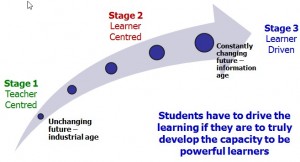Moving from Teacher Centred to Learner Driven Learning
- On 13-08-2014
I have been having a lot of interesting presentations at schools lately where I have been brought in to work with the teachers on formative assessment or differentiation or backward planning or some other pedagogical or curriculum strategy with the aim of building teacher capacity to create great learning environments.
One of my key messages is that there is an underlying context that the teachers and the school really need to grapple with if they are going to be successful at enacting any of these strategies.
If they want the new approach to succeed they have to shift not only their pedagogical and curriculum planning practices but their entire context about learning
Different contexts of learning and the perception of who is responsible for learning creates different actions, habits and even use of language for both teachers (lead learners) and students (learners). I have discussed the importance of habits and structures in earlier posts (here, here and here) but on this occasion I want to point out that different contexts makes some things easier, some things more challenging, and require different expectations, behaviours and strategies to make them work.
For example, I have been sharing the following table in many of my presentations of late to highlight to teachers this exact point. I developed it after seeing the Stages of Personalized Learning Environments Chart by Barbara Bray & Kathleen McClaskey.
| Teacher Centred Environment | Learner Centred Environment |
Learner Driven Environment |
|
|
|
Now I am not saying that learning should not be teacher centred at times. Direct Instruction, which is a teacher centred strategy, has been shown to be a statistically significant approach to developing learners. However, it is when we get stuck in one context that problems arise. As you move from left to right in the table the skill level and depth necessary for the students to learn increases. A learner driven environment requires learners to have higher order skills quite often identified as 21st Century competencies. You will in fact find that the best academically performing students display many of the learner driven behaviours and drive their own learning despite what is happening in their classes.
However I want to point out that if a teacher and a school has not structured its learning environment, and planned in a coherent and cohesive way to develop students to be driving their learning through the years of being at the school, then they are not fulfilling their purpose as an educational institution. Whilst it was passable in some ways to have teacher centred learning in the past this is no longer the case. For the constantly changing world we are preparing learners for, it is critical that they develop the capacity to drive their own learning. Unless we are focused on creating the opportunities for this to occur then we fail as educators and educational institutions.
For more research and reading around this topic check out:
- The New Pedagogy- Students and Teachers as Learning Partners (Michael Fullan)
- An Essential Question for Developing Student-Centered Classrooms (Alan November)
- Literature review: Student-centred schools make the difference (AITSL)
- Improving Schools: The Prerequisites for Personalizing Learning
- Personalize your learning environment
- 10 Trends for Personalized Learning in 2014
- Creating Learner Centric Environments
- Uppervention: Meeting the Needs of Gifted and Talented Students
- 5 Tips For Making Your Class As Addictive As A Game
[Tweet “If you want the new pedagogical approach to succeed you have to shift your entire context about learning”]


0 Comments